Guiding the Eye and Moving the Mind
and Law of Equal Destination or Same Fate
This principle or method is about movement or, of course, suggested movement. We experience objects as a whole when they have the same movement or direction. The most straightforward use of this law in graphic narrative is making someone (or something) stand out in a crowd by having them move in a different way then their surroundings, making it possible to follow him, her or it through a scene.
The movement of your focal point could be in a different direction, different speed or different manner than the background (which is not necessarily ‘in the back’). That which moves in a quiet environment, standing still between moving elements or something that behaves unexpectedly attracts attention.
In The Fisher King (1991) (US Link) this method is used when a hopeless romantic and homeless man (Robin Williams) follows the woman he loves (Amanda Plummer) through the station. She, like him, is a bit weird. Her manner of movement stands out. He watches her, beguiled. Their movement through the packed station becomes even more easy to follow when all the people around them start to waltz, symbolizing his mood.
Terry Gilliam, The Fisher King (1991)
Even if movement is only suggested and nothing actually moves it can help focus, guide the eye and find what behaves differently. In comics the use of motion lines is quite common. It is assumed that Rodolphe Töpffer who is considered Father of the Comic Strip was the first to use them somewhere between 1800 and 1850. Both the American as the Japanese comics are known for putting them to great use. These lines not only suggest movement but double as rulers to guide the eye toward the action. In this classic example Osamu Tezuka ‘the godfather of the manga’ guides the eye via motion lines past several impacts bouncing it toward the hero Astro Boy in the top left corner.
Movement can be signified in many different ways and establish contrast in many different ways.
In a page from one of the albums of the series Corto Maltese Hugo Pratt elongates the shapes of rocks to give the impression of a direction. Making the hero stand out by his upright position that goes against the movement of the mass.

Osamu Tezuka, Astro Boy (undated but somewhere between 1952 and 1968)

Hugo Pratt, Corto Maltese – The Ethiopians (1972-1973)
This Gestalt law of equal direction works especially well if the suggested movement (or action-in-a-direction) is a characters gaze. As social beings the human face attracts our attention . Combining this fact with the fact we (human beings) are very aware of the where other people are looking at especially if they are looking at us makes breaking the fourth wall a technique that can achieve great impact.
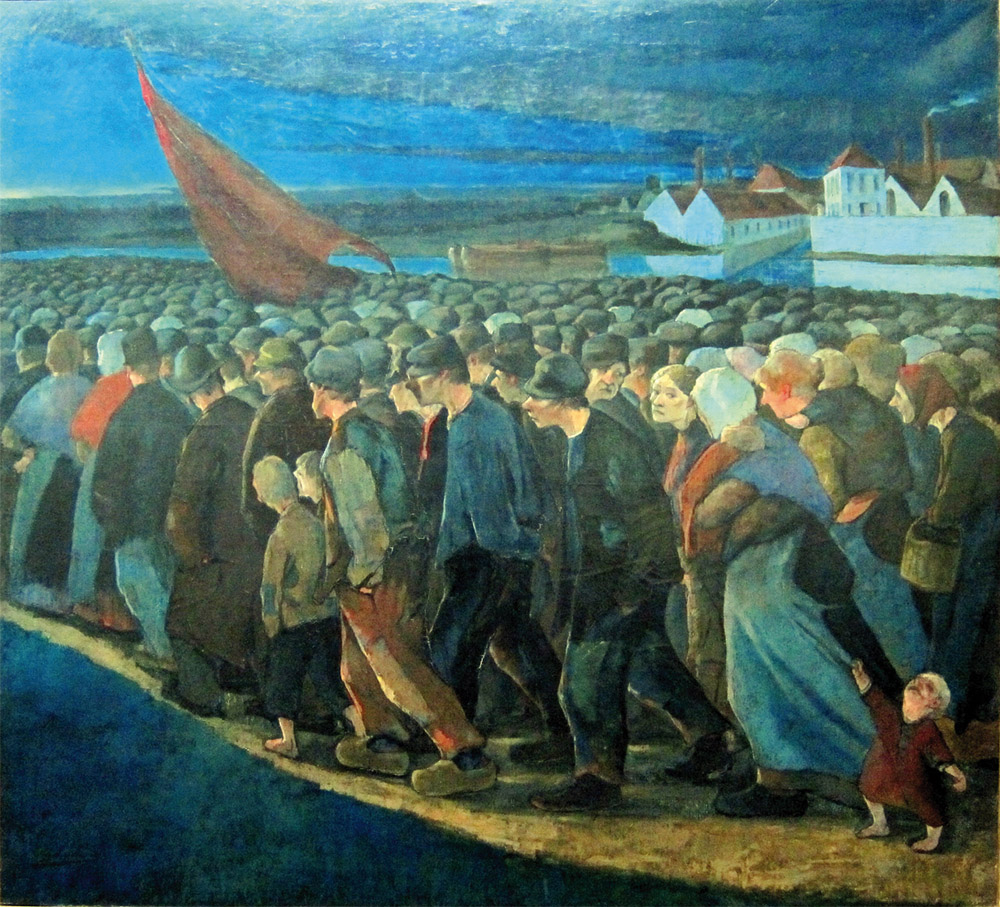
Baron Eugène Laermans, A strike evening (1893)
It is always a bit unsettling or unexpected in the least if a fictional character suddenly looks at you, the viewer. In Baron Eugène Laermans, A strike evening (1893) one woman in the marching crowd looks in a different direction breaking the fourth wall (looks directly at the viewer). She gives the crowd a human face, draws our eyes and our attention. She seems to want something. Our sympathy? Or is she accusing the viewer? Eddie Campbell uses the same technique in this sequence from From Hell (1989-1996 & 1999) (US Link). Queen Victoria changes her gaze to make sure what she demands is understood and failure not an option….
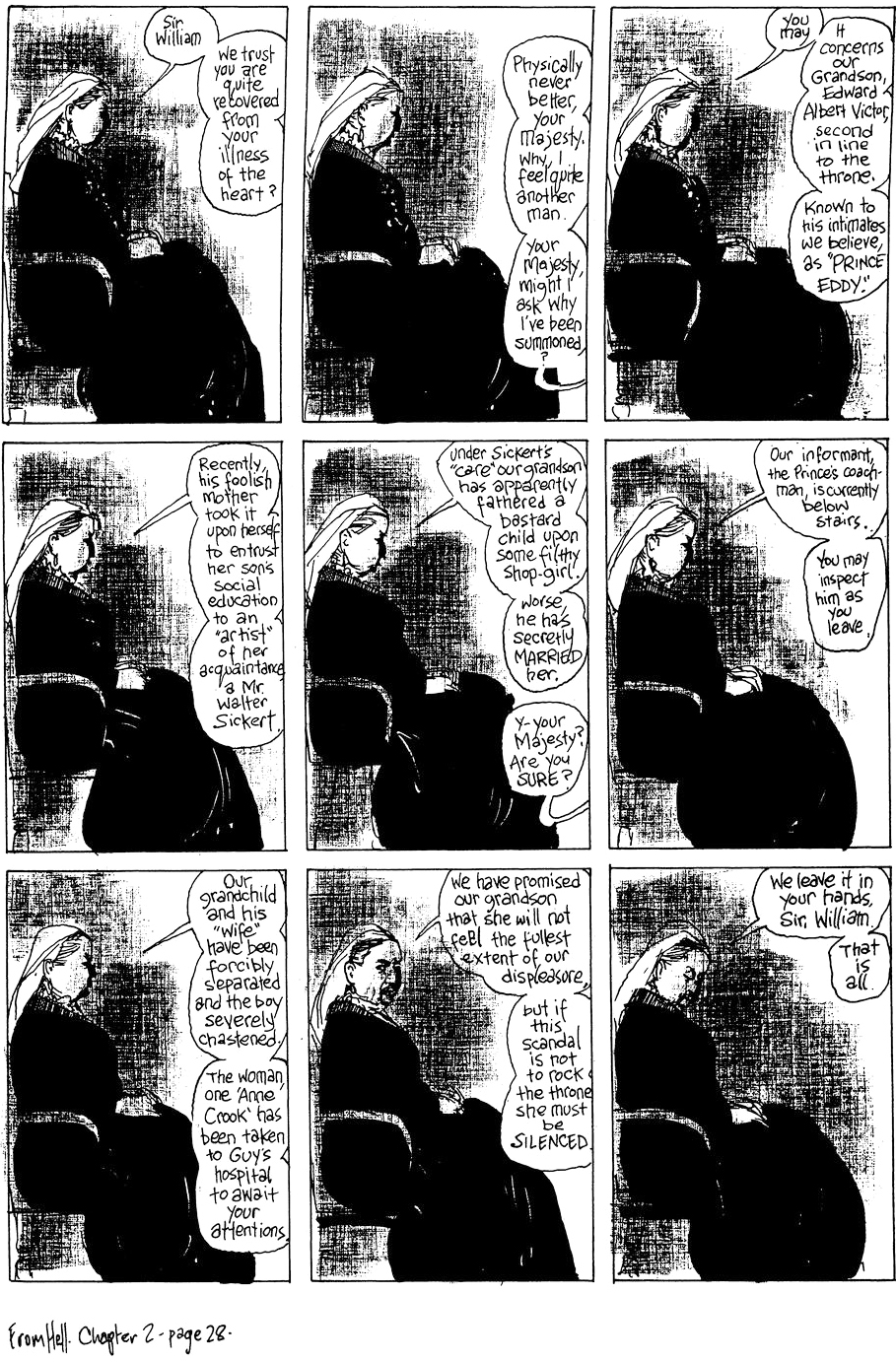
Eddie Campbell, From Hell (1989-1996 & 1999)
Used with kind permission of Mr. Campbell
This law is not only helpful to distinguishing a person or an element from its surroundings but also to illustrating a mood. Stillness in a hectic scene can show determination for instance. In his movie Ran (1985) (US Link) Akira Kurasawa guides the eye not only to the face of his protagonist but to his emotion while he sits motionless between flying flaming arrows. The direction of the arrows is (quite unexpected) both from left to right as from right to left. A completely hectic situation making the still white stare stand out even more.
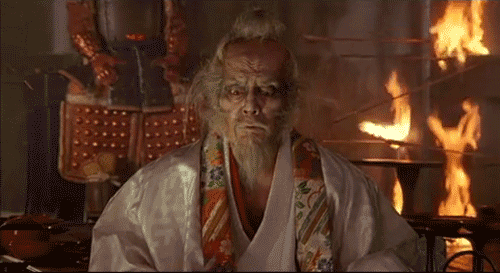
Akira Kurasawa, Ran (1985)
Kurasawa is famous for the use of movement in his movies. He was a master in the direction and choreography of people and action and he even incorporated the movement, power and atmosphere of the elements. Sometimes using the weather to accentuate a movement or mood. Sometimes to provide a sharp contrast, guiding the attention to a motionless focal point. In Rashomon (1950) (US Link) three strangers meet seeking shelter from the pouring rain. Two of them start telling the third of a disturbing event that they have witnessed. Their motionless speechlessness, the shock, in heavy contrast with the all encompassing rain.
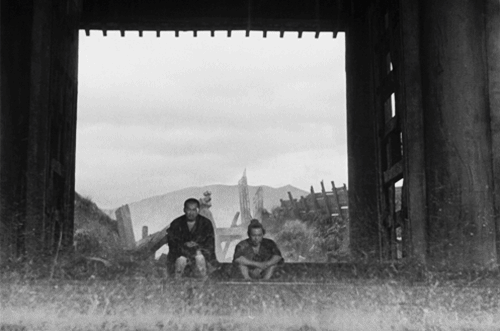
Akira Kurasawa, Rashamon (1950)
Please let me know if you have some other great examples where this technique is used!
In case you’re wondering about why I’ve asked Eddie Campbell for permission to use his work and none of the other artist; I’m using all artwork under the Fair Use Law, but decided to let all living artists (who are not presented by major bureaucratic agencies) know I appreciate their work and use a small part of it in this context on this blog.
Readers Tips:
Suggested by Carl S. Host of The Movie Palace Podcast.
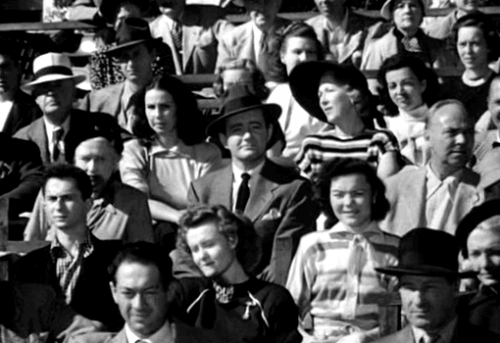
Alfred Hitchcock, Strangers on a train (1951)
2 Comments
Join the discussion and tell us your opinion.
Enjoyed reading this, found it very interesting. After seeing the image from Ran, my thoughts turned to the scene in Hitchcock’s Strangers on a Train where the character of Bruno sits in the crowd at a tennis match, staring straight ahead whilst the other spectators follow the action from side-to-side. Can’t see a way to attach the image, but it seems like another good example to me.
Thank you! That indeed is a perfect example. It’s a shame you can’t post any pictures in the comments… Since you also contacted me on twitter (which is perfect for sending gifs) I know which clip you mean. I’ll add it in! — For all the future readers; Carl hosts a great podcast: The Movie Palace. A talkshow about the films of the Golden Age of Hollywood. You could follow him on twitter via @MoviePalacePod to stay up to date.